You are using an out of date browser. It may not display this or other websites correctly.
You should upgrade or use an alternative browser.
You should upgrade or use an alternative browser.
32DFT Carb Icing Issues, Heating with Coolant, Heated air Intake and other methods of Heating,
- Thread starter westgl
- Start date

Help Support Classic Goldwings:
This site may earn a commission from merchant affiliate
links, including eBay, Amazon, and others.
1100 sidecovers https://www.nathanielsalzman.com/motorcy ... goldwings/
anyone know what the front wheel is from?
anyone know what the front wheel is from?
hmmm it looks like the old star wheel....... after market wheel ...like the lester is ....made for the oldwings back in the day
might be an 83 magna
https://www.ebay.ca/sch/i.html?_odkw=110 ... l&_sacat=0
brake discs look like these too
https://www.ebay.ca/itm/1983-Honda-Magna ... aa&vxp=mtr

https://www.ebay.ca/sch/i.html?_odkw=110 ... l&_sacat=0
brake discs look like these too
https://www.ebay.ca/itm/1983-Honda-Magna ... aa&vxp=mtr

- Joined
- Dec 3, 2009
- Messages
- 22,403
- Reaction score
- 238
- Location
- Van Nuys Ca.
- My Bike Models
- 1983 Interstate
2018 KLR 650
2018 BMW S1000 RR
- My Bike Logs forum link
- https://classicgoldwings.com/forums/dan-filipi.122/
Now that my runners are done and I have the jetting pretty close, the plenum needs heat.
I'm going to put a 2" wide 1/8th" plate on the plenum bottom, using the threaded stud and a bolt to hold it tight in contact with the plenum.
Using either 1/2" or 3/8" copper tube, I'll solder to this plate.
1/2" fittings should line up for a box pattern with a T in the center of front and rear.
I'll tap in a fitting at the rear of the thermostat housing and one into the lower hose fitting like where this one is on the 1200. Steve83 gave me a pump cover that has a flat space where that nipple is to tap in.
All the flexible lines will be left over clear tubing I have so I can see flow.
I'm going to put a 2" wide 1/8th" plate on the plenum bottom, using the threaded stud and a bolt to hold it tight in contact with the plenum.
Using either 1/2" or 3/8" copper tube, I'll solder to this plate.
1/2" fittings should line up for a box pattern with a T in the center of front and rear.
I'll tap in a fitting at the rear of the thermostat housing and one into the lower hose fitting like where this one is on the 1200. Steve83 gave me a pump cover that has a flat space where that nipple is to tap in.
All the flexible lines will be left over clear tubing I have so I can see flow.
I guess I'm going to be the one to ask a stupid question. Have any of you actually experienced Carb icing while riding. I know on the Continental and Lycoming aircraft engines they redirect air off the cylinders to stop carb icing and it is very effective. I must admit I normally don't ride when it gets down to low 30s.
- Joined
- Dec 3, 2009
- Messages
- 22,403
- Reaction score
- 238
- Location
- Van Nuys Ca.
- My Bike Models
- 1983 Interstate
2018 KLR 650
2018 BMW S1000 RR
- My Bike Logs forum link
- https://classicgoldwings.com/forums/dan-filipi.122/
Excellent question.[url=https://www.classicgoldwings.com/forum/viewtopic.php?p=102344#p102344:2hm4b5oc said:OldWrench » Wed Nov 06, 2013 9:37 am[/url]":2hm4b5oc]
I guess I'm going to be the one to ask a stupid question. Have any of you actually experienced Carb icing while riding. I know on the Continental and Lycoming aircraft engines they redirect air off the cylinders to stop carb icing and it is very effective. I must admit I normally don't ride when it gets down to low 30s.
I took flying lessons and it's always been my understanding that the danger is icing in the carb venturi which can stop fuel flow and kill the engine.
We'd turn the heated air on occasionally to melt any ice away and under certain situations.
On the bike I'm finding we need plenum heat to vaporize the fuel better and not so much to prevent ice. Quite a few times mine ran lopey at idle during the first start and run but smoothed out after shutting it down and letting the runner heat transfer to the plenum for 5 minutes then starting up.
My only conclusion is the plenum heat increased vaporization.
I've had my private license for many years, just can't afford to fly any more. I know with the naturally aspirated engines like on the Cessna 150, 172, 182 carb icing is a real issue. I did experience it a couple of times and as soon as I pulled the carb hit on the engine would stumble a little then smooth right out. After those experiences I kept the carb heat on anytime the air temp was freezing or had a lot of moisture or high humidity. The Cessnas used the Continental engine.
- Joined
- Dec 3, 2009
- Messages
- 22,403
- Reaction score
- 238
- Location
- Van Nuys Ca.
- My Bike Models
- 1983 Interstate
2018 KLR 650
2018 BMW S1000 RR
- My Bike Logs forum link
- https://classicgoldwings.com/forums/dan-filipi.122/
There's different running conditions comparing a plane engine with our engine.
A plane engine spends most of its time at altitude with the throttle set well beyond part throttle.
Our bike we may cruise part throttle for an hour or more.
Piper, correct me if I'm wrong but the plane icing can happen more at the venturi than the throttle plate. I believe we could have icing more at the throttle plate.
A plane engine spends most of its time at altitude with the throttle set well beyond part throttle.
Our bike we may cruise part throttle for an hour or more.
Piper, correct me if I'm wrong but the plane icing can happen more at the venturi than the throttle plate. I believe we could have icing more at the throttle plate.
- Joined
- Dec 3, 2009
- Messages
- 22,403
- Reaction score
- 238
- Location
- Van Nuys Ca.
- My Bike Models
- 1983 Interstate
2018 KLR 650
2018 BMW S1000 RR
- My Bike Logs forum link
- https://classicgoldwings.com/forums/dan-filipi.122/
badorderbob
Well-known member
Just for some info Dan,..that housing will work/fit perfectly in place of yours. I used that for my first trial of heating my plenumn. And what I can tell you it will be hotter at the begining of the tubing and cooler at the end of the line. Now if you really want it really hot ,( where you can't handle it), you need to come up with some kind of a bigger chamber than just line. Flow has to come in, accumalate, and obviously leave. Whatever you use make the chamber as big as you can. I'll add some ideas later!! Good luck,.. :hi: Bob
hmmmmm the icing issue ...well when things get set up right ..icing is a smaller issue ...so im going to be reserved some on this issue ...some who taken the time to get things set up and jetted right are having very little issues with icing .....cant say that im totally there but issue has benn getting smaller as conditions for icing have increased around here ...on going deal right now ..no chixxled in stone issue for me as in plan yet ...hard for me to discount rubber runners or other deals ive built in this manifold ....what a pleasure it is to work with carbs that are decent in design ...the stock 4 carbs are totally defeated of it advantages by being CV lag carbs ...this is obvious to antone who has experience with one of these weber single two barrel set ups dialed in right ...just top of the line in carbs to go with top of the motor Honda never got right or prevented by epa bs
- Joined
- Dec 3, 2009
- Messages
- 22,403
- Reaction score
- 238
- Location
- Van Nuys Ca.
- My Bike Models
- 1983 Interstate
2018 KLR 650
2018 BMW S1000 RR
- My Bike Logs forum link
- https://classicgoldwings.com/forums/dan-filipi.122/
It sure is nice to work with a single carb instead of 4, and one that can actually be adjusted.
Lots of customizing in jetting can be done.
As far as icing goes, I don't think there will be any problem with it.
What I'm referring to in regards to heating the plenum is to heat it to help atomization, not eliminate icing.
I've experienced a very cold plenum and how it runs and just 5 minutes later seen the difference a warm plenum makes in smoothness and acceleration.
I'd say could certainly run without heat but to get good atomization and going where I'm going, best possible mpg, heat is a must.
Lots of customizing in jetting can be done.
As far as icing goes, I don't think there will be any problem with it.
What I'm referring to in regards to heating the plenum is to heat it to help atomization, not eliminate icing.
I've experienced a very cold plenum and how it runs and just 5 minutes later seen the difference a warm plenum makes in smoothness and acceleration.
I'd say could certainly run without heat but to get good atomization and going where I'm going, best possible mpg, heat is a must.
hmmm neat angle to look at it from ....old Pontiacs had spider manifolds heated with exhaust cross over .. boy seemed those 4 barrels ran really well ...hmmmmm
If you talk to Tom he will tell you that heating the plenum is needed to help 1) atomisation and 2) stop the icing. He doesn't say that icing will be a definite problem he says atomisation is enhanced with heat. I talked with him from the UK when I bought my carb, he knew straight away which plenum I was going to use and we discussed the posability of building a small box under the plenum floor which is I understand is flat, the box only needs to be about 13mm or 1/2" for the imperialists among us. I posted on here a aluminum soldering kit, click here --->https://www.ebay.co.uk/itm/291010365830?ssPageName=STRK:MEWAX:IT&_trksid=p3984.m1423.l2649 .
It workes at about 390 degrees centigrade which is 734 farenheit, cold enough not to damage the aluminium to make the box and fix to the plenum. But high enough to withstand the coolant fluid passing through it. This box could be easily tapped into the coolant tubes underneath the plenum once filled the plenum would heat very quickly but never get too hot.
As an after thought I went and looked up the video on You tube it is impressive stuf. see it here https://www.youtube.com/watch?v=jijW310xvp4
Ian
It workes at about 390 degrees centigrade which is 734 farenheit, cold enough not to damage the aluminium to make the box and fix to the plenum. But high enough to withstand the coolant fluid passing through it. This box could be easily tapped into the coolant tubes underneath the plenum once filled the plenum would heat very quickly but never get too hot.
As an after thought I went and looked up the video on You tube it is impressive stuf. see it here https://www.youtube.com/watch?v=jijW310xvp4
Ian
It is very tricky to make that stuff work. I tried a few brands. They all stick and look real pretty if you clean properly, but I would give mine a tap, a small tap, with a hammer and they failed. I decided I couldn't trust it.
Piper, correct me if I'm wrong but the plane icing can happen more at the venturi than the throttle plate. I believe we could have icing more at the throttle plate.
You are correct because the throttle plate is normally almost wide open. What happens is you gradually lose power and at first it is almost unnoticeable. I'm not that familiar with the Lycoming engine that that most pipers use, but I'm sure it is pretty much the same a Continental.
I experienced carb icing coming back from Tahoe one night and it really got the pucker factor going.
- Joined
- Dec 3, 2009
- Messages
- 22,403
- Reaction score
- 238
- Location
- Van Nuys Ca.
- My Bike Models
- 1983 Interstate
2018 KLR 650
2018 BMW S1000 RR
- My Bike Logs forum link
- https://classicgoldwings.com/forums/dan-filipi.122/
Yes me too.
I pulled the heat on and listened as the engine sputtered then smoothed out.
It's a real awakening how real the problem can be.
I pulled the heat on and listened as the engine sputtered then smoothed out.
It's a real awakening how real the problem can be.
- Joined
- Dec 3, 2009
- Messages
- 22,403
- Reaction score
- 238
- Location
- Van Nuys Ca.
- My Bike Models
- 1983 Interstate
2018 KLR 650
2018 BMW S1000 RR
- My Bike Logs forum link
- https://classicgoldwings.com/forums/dan-filipi.122/
Manifold heat just about done. Have to get some coolant hose.
That's tinning flux smeared on the 1/2 copper getting ready for mating to my heat plate.
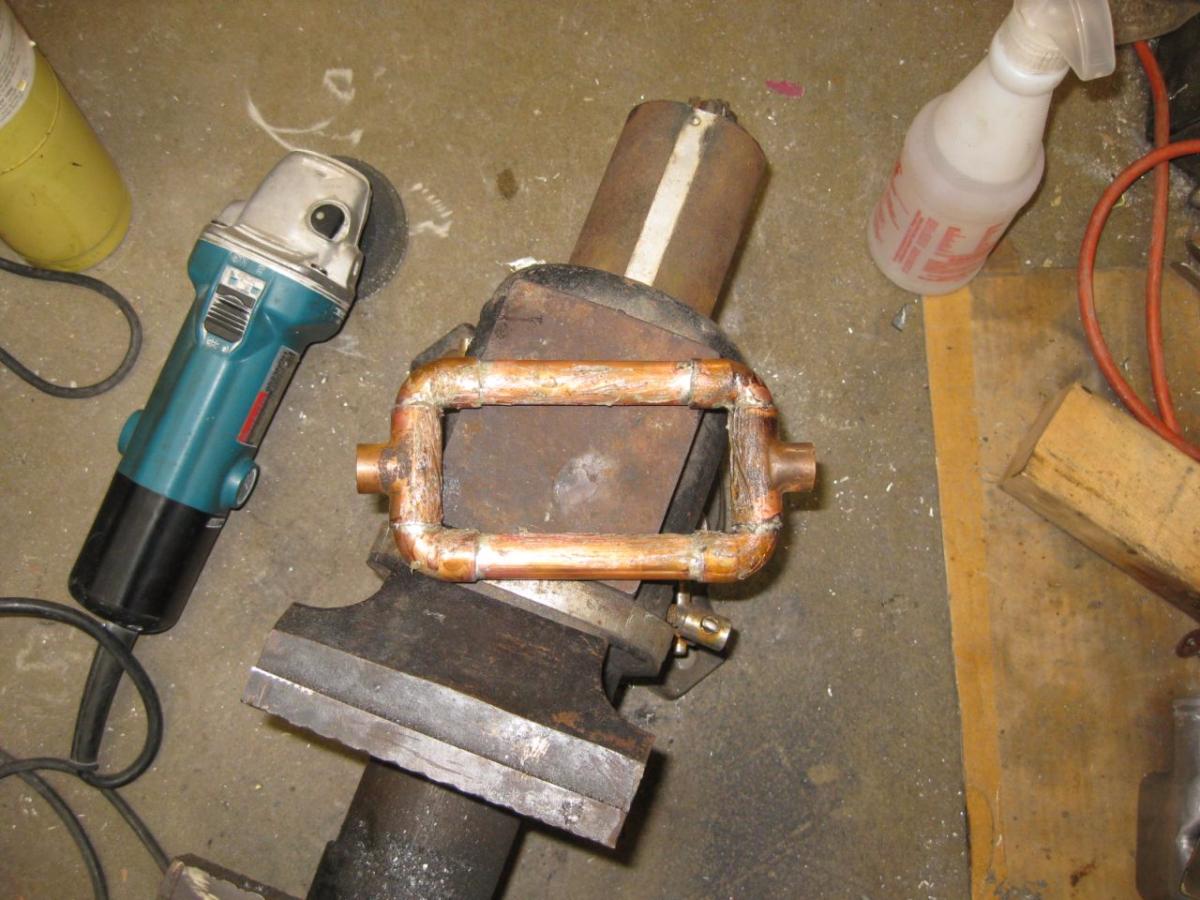
(There's the victim on the right for the next step)
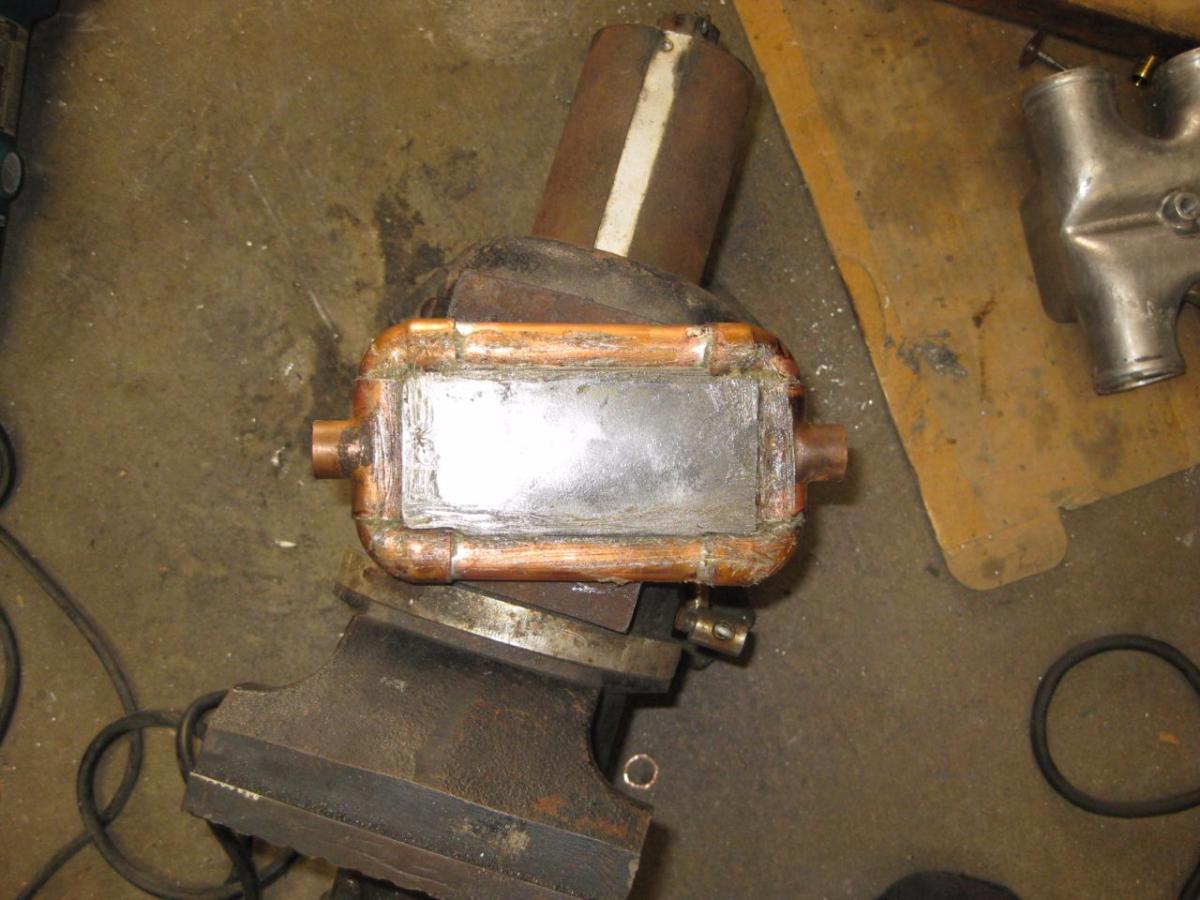
2 inch wide 1/8th inch thick steel plate.
Center drilled and bolted to the plenum.
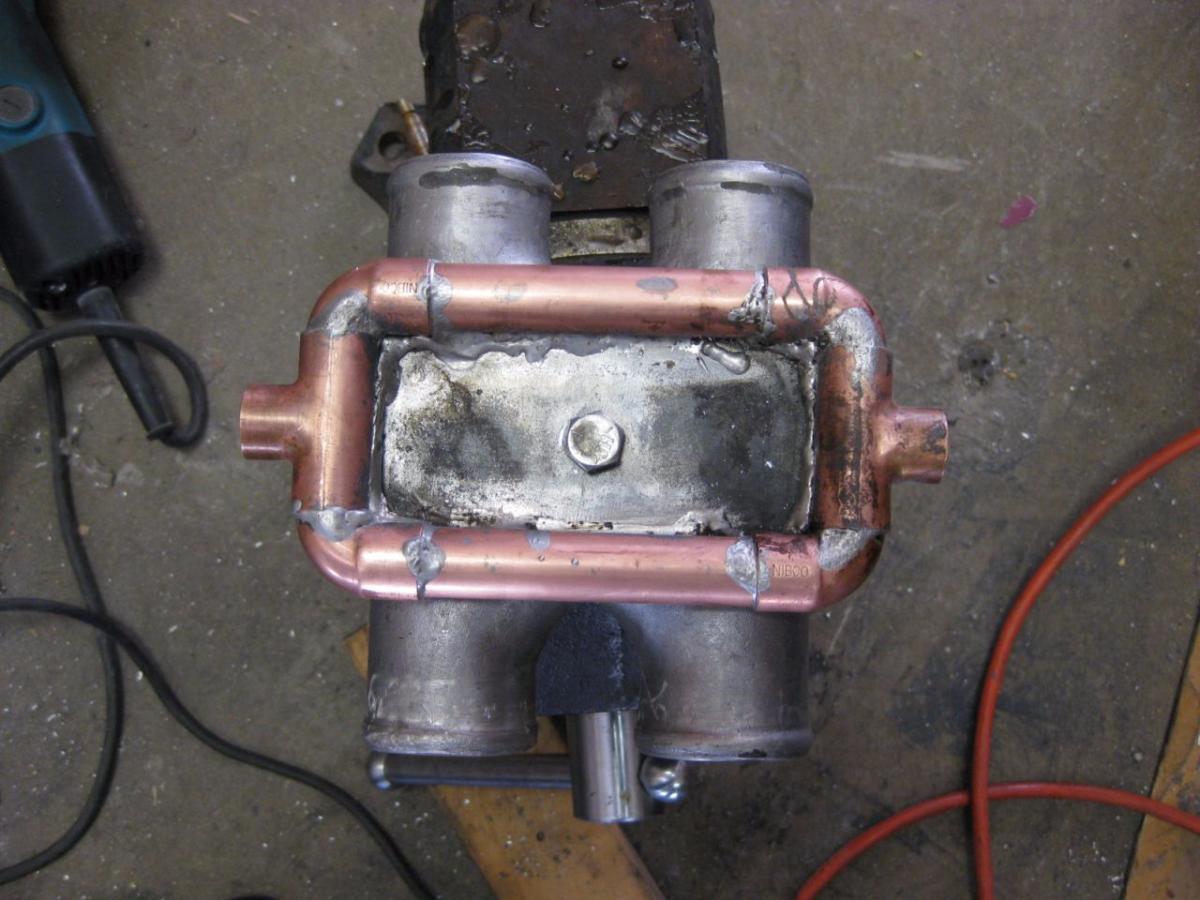
Bolted down, pulls the plate and copper tight to the plenum.
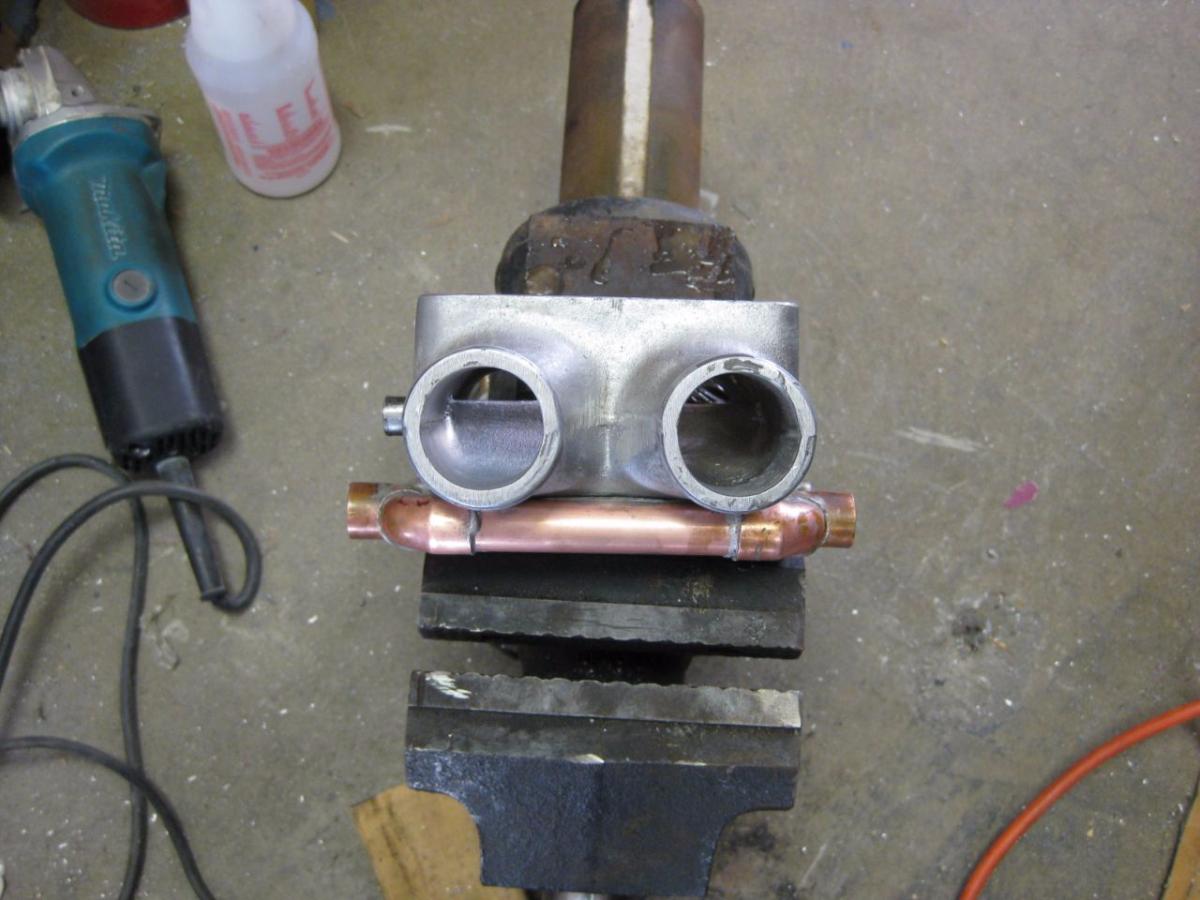
Fittings to 1/2" I.D hose.
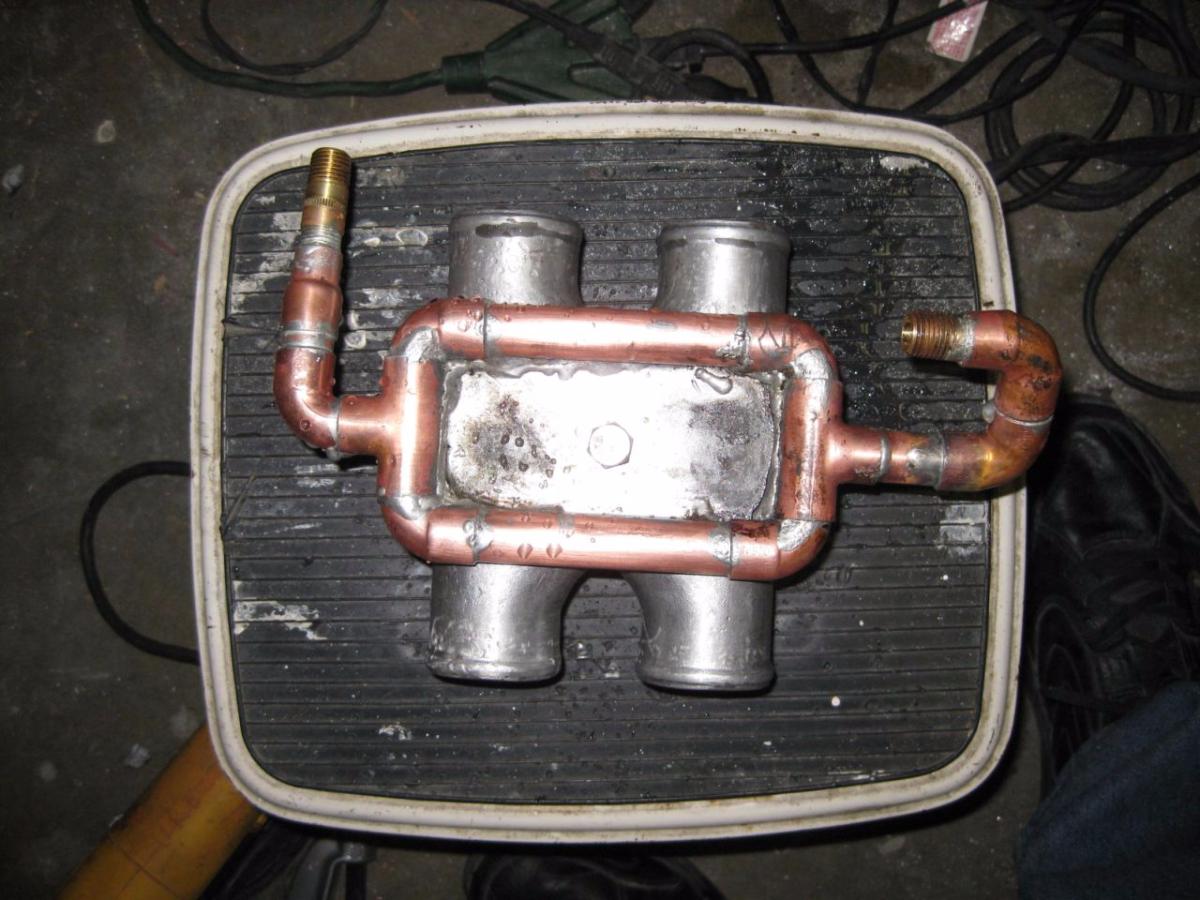
Plumbed in to bike.
I tapped to 1/4" NPT at rear of the coolant crossover tube housing.
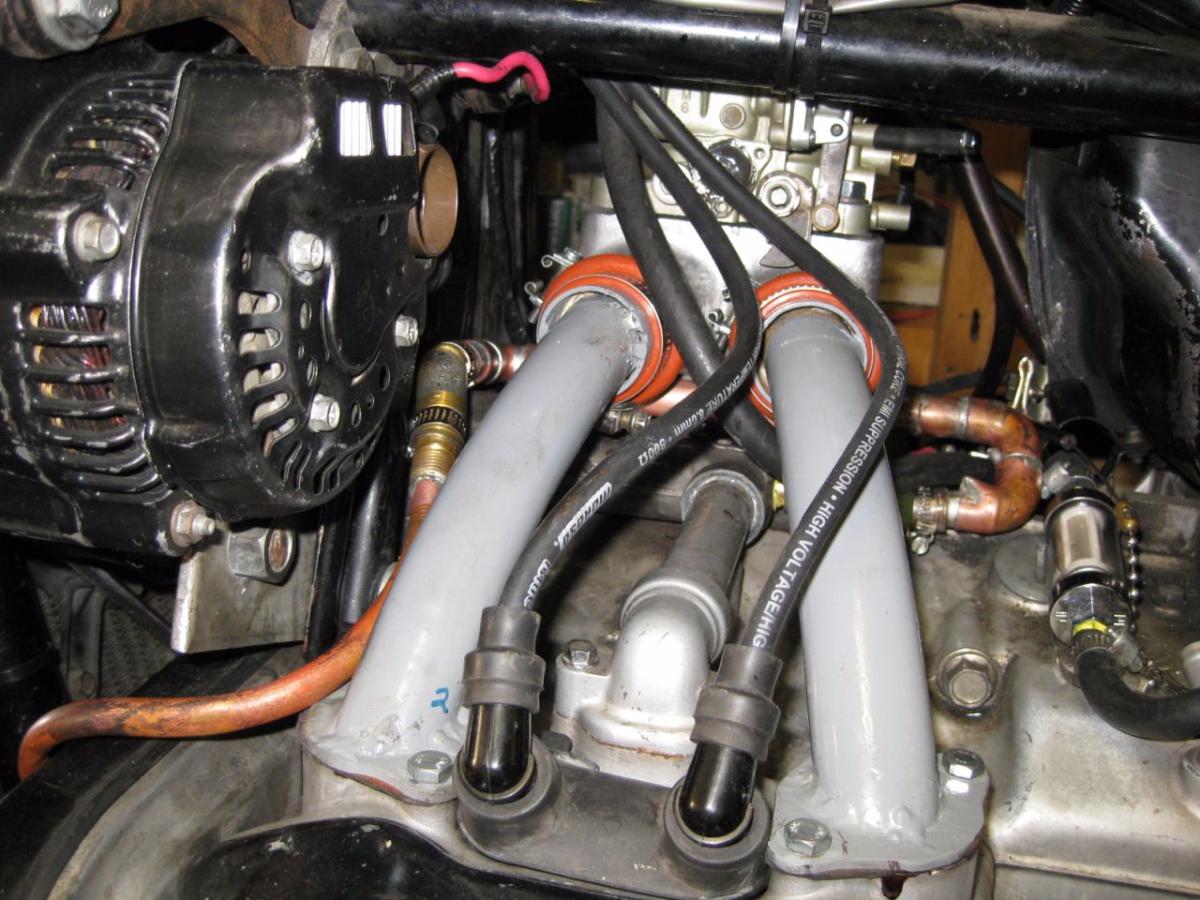
Tapped to 1/4" NPT in the water pump cover.
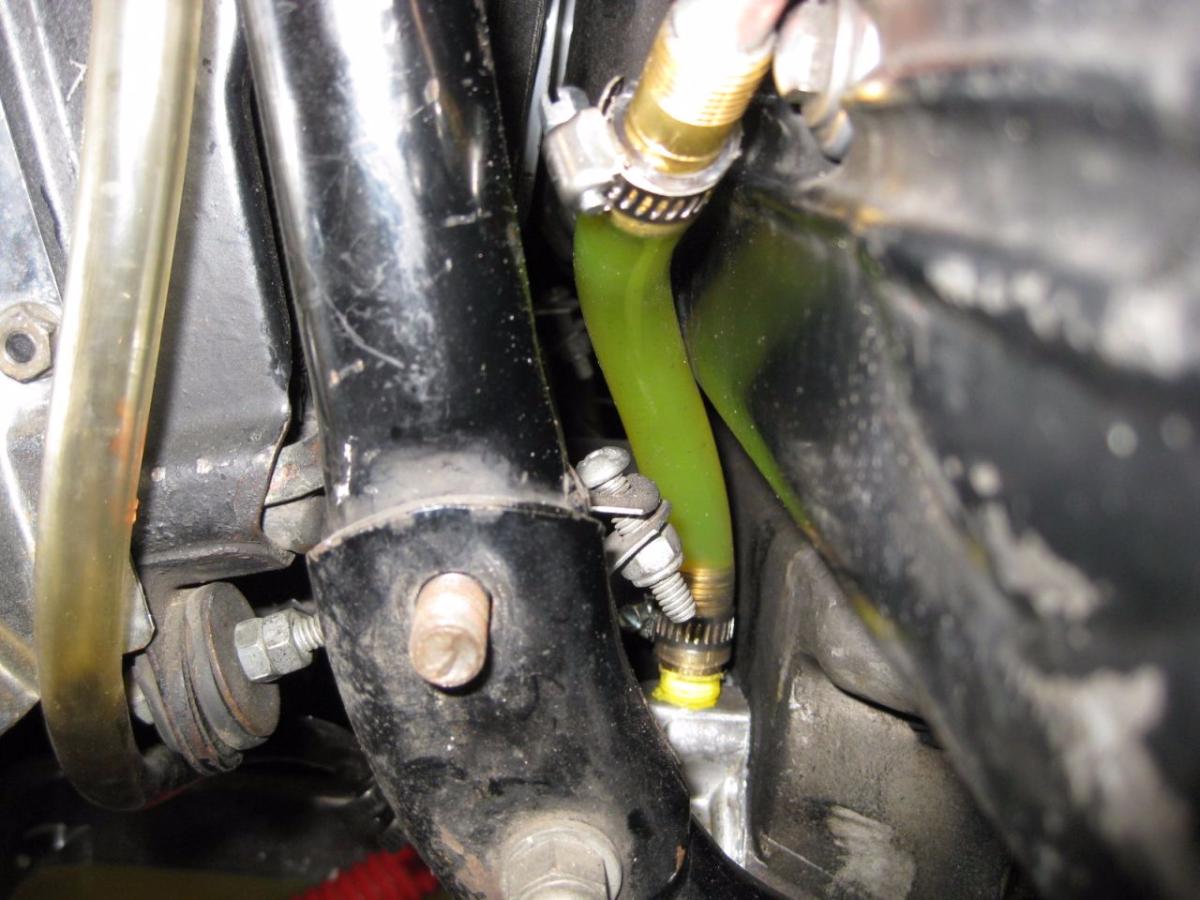
I need to get some 1/2" I.D heater hose because the clear poly tube can't take the heat and pressure but it gave me a look see to check flow.
This is very much a success so far.
In the garage starting at 52 degrees, I locked the throttle at 1500 rpm then after a minute running rpm increased to almost 2000 rpm.
This matched as the heat coming into the tubes telling me better vaporization started taking place.
After under 5 minutes, the tubes were too hot to touch and the plenum was warm.
With no heat, the plenum would be nearly ice cold and stay that way.
My findings so far is that heat is most definately needed.
I plan to test my heat plate well then insulate it.
It is staying in place.
Oh, and about the coolant getting cold at the discharge end?
I didn't find that to be true. That end is still WAY to hot to touch.
That's tinning flux smeared on the 1/2 copper getting ready for mating to my heat plate.
(There's the victim on the right for the next step)
2 inch wide 1/8th inch thick steel plate.
Center drilled and bolted to the plenum.
Bolted down, pulls the plate and copper tight to the plenum.
Fittings to 1/2" I.D hose.
Plumbed in to bike.
I tapped to 1/4" NPT at rear of the coolant crossover tube housing.
Tapped to 1/4" NPT in the water pump cover.
I need to get some 1/2" I.D heater hose because the clear poly tube can't take the heat and pressure but it gave me a look see to check flow.
This is very much a success so far.
In the garage starting at 52 degrees, I locked the throttle at 1500 rpm then after a minute running rpm increased to almost 2000 rpm.
This matched as the heat coming into the tubes telling me better vaporization started taking place.
After under 5 minutes, the tubes were too hot to touch and the plenum was warm.
With no heat, the plenum would be nearly ice cold and stay that way.
My findings so far is that heat is most definately needed.
I plan to test my heat plate well then insulate it.
It is staying in place.
Oh, and about the coolant getting cold at the discharge end?
I didn't find that to be true. That end is still WAY to hot to touch.
this is cool ...well lets hope its just right I see no reason at all why this wont do it ...





